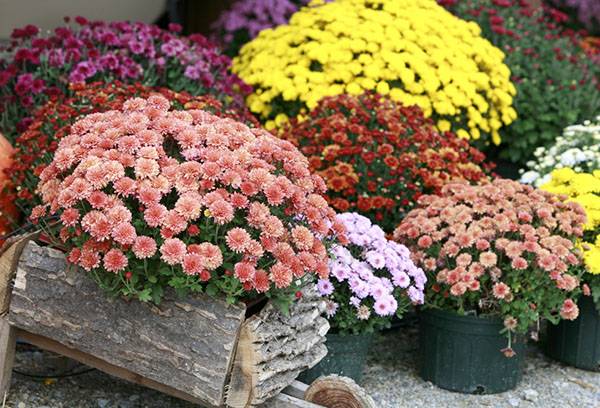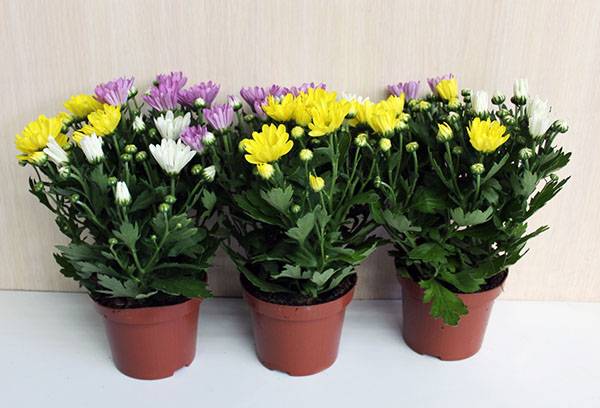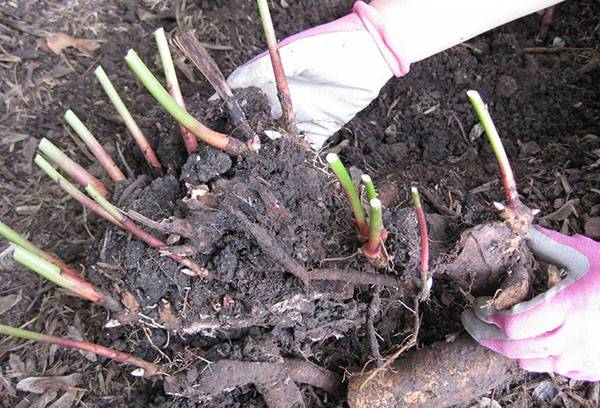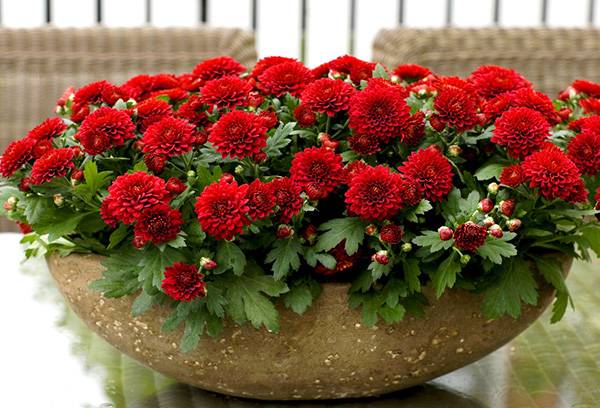All about caring for home chrysanthemum from planting to wintering
Content:
Chrysanthemum is a bright and unpretentious flower, associated with warm colors of autumn and a golden garden, which can be grown at home, in an ordinary flower pot. It is not difficult to take care of home chrysanthemum, it is often found on window sills of indoor plant lovers closer to winter, when other plants rest after flowering. Sometimes such plants are bought as disposable to throw away when all the buds have fallen, but with proper care, this attractive bush is able to delight its owners with bright flowers for many years.
Plant selection and transplant
A chrysanthemum in a pot is a rather miniature plant, which during flowering resembles a bouquet. But sometimes under the guise of compact varieties in stores there are ordinary large plants designed for inattentive customers. Small sizes are achieved by using special drugs that inhibit the growth of branches and stimulate the formation of buds. These bushes quickly cease to bloom after purchase and can grow into real giants. Such specimens have to be planted in open ground in the spring.
For growing in an apartment, most often they use compact varieties of Chinese or silky-leaved chrysanthemums, characterized by a long flowering period, while not forming high stems and long branches. Varieties can be large-flowered, with an open bud diameter of up to 5 cm, and small-flowered - with flowers up to 2.5 cm in size. Some varieties of Korean chrysanthemum grow well in the pot, spherical bushes of the Multiflora series are especially popular, they are also called spherical. On sale you can find Indian chrysanthemums, which are not intended for open ground and are successfully grown in conservatories and on balconies.
In order not to make a mistake when buying, you need to carefully examine the plants, paying attention to the proportionality of the leaves and stems, the presence of pests, and after that - arrange quarantine for 2 weeks. Indoor flower in the pot needs to choose the right location - the place should be cool. It is advisable to choose a window facing east or west. You should not place chrysanthemums in a pot on the south side - then flowering will have to wait a very long time or it may not come at all. On the north side, a flower may die from a lack of light. In summer, plants are best taken out on a ventilated balcony or planted in open ground.
Planting chrysanthemums in a pot at home is carried out in the same way as when working with ordinary indoor plants: the container is not too large, drainage is placed on the bottom and it is filled with garden soil mixed with peat and humus, or they are buying ready-made flower soil. Acidified soils should be avoided. Young plants are transplanted into a fresh substrate every spring, while the size of the container does not change. After four years of age - once every 2 years, the pot should be 2-3 cm longer. The flowering period begins in the fall, but in the spring it can be repeated if the temperature does not exceed comfortable for plants + 15-18 ° C. In summer, it is best to keep flowers at + 20-23 ° C. In winter - at + 3-8 ° C.
Propagation of indoor chrysanthemum and plant care
Properly caring for chrysanthemum at home is not difficult. She really loves water, because the soil in the pot must always be moist.But you should not fill the flower too much - this can cause rotting of the root system, fungal diseases and lead to the death of the plant. To choose the optimal watering regime, you need to focus on the conditions of detention. In rooms with dry air it is better to water twice a day, additionally spraying leaves from the spray gun. It is recommended to install a chrysanthemum on a pallet with wet expanded clay or use a special device to humidify the air.
If the plant has just been replanted, the first time it is necessary to apply fertilizer no earlier than after 14 days, and when using humus in the earthen mixture, after a month. In spring, they are fed with nitrogen fertilizers regularly, every 10 days, to stimulate flowering, and by mid-July, phosphorus-potash, for example universal fertilizers for flowering plants, can be used. During the period of active vegetation, the bush needs to be pinched periodically to create a spherical shape and increase the number of shoots. Usually 2-3 nipples are enough.
Tip
Flowers develop best in the autumn, when daylight hours do not exceed 8 hours. Due to this feature, it is possible to achieve chrysanthemum blooming artificially by covering it with a light-tight cap in the middle of the day. When the plant fades, the shoots are pruned and placed in a cool room where the temperature does not exceed +5 ° C.
For the propagation of chrysanthemums most often use several methods: dividing the bush, layering, cuttings, sowing seeds. When dividing the bush, the root system can suffer, and the cuttings and the seed method are quite painstaking options in which greenhouse conditions, regular ventilation of the shoots and a long wait for the result are needed. If you propagate chrysanthemum by layering, you can get up to 6 new bushes per season, which can bloom in the first year of life.
The resting period of indoor chrysanthemum
Caring for home chrysanthemum during the flowering period is simple: you need to remove the yellowed leaves, dried buds and water the plant abundantly. If this is not done, the whole bush may dry. When the chrysanthemum fades, the overgrown stems are shortened to 10-15 cm, but the young ones try not to touch. In the spring it is also recommended to carry out stimulating branching pruning.
In winter, a period of rest begins, which should be prepared in advance. There are several ways to winter a chrysanthemum correctly.
- Leave the plant on a bright and cool balcony or in the stairwell. You can put it in the cellar, where there is additional illumination. At a temperature of + 3-8 ° C, watering should be done no more than 1 time per month.
- You can leave chrysanthemum on a cold windowsill, where there is enough light. But then pruning is not so cardinal - only dried buds, branches and foliage are removed. Water as usual.
- Many owners of heat-loving garden varieties place plants in a dark basement, cutting bushes to 10-15 cm and watering the soil in a pot 2 days before wintering. You do not need to look after such a plant until spring.
- Wintering is possible in the open ground with the use of covering material. Before frost, the plant in the pot is cut off, covered with dry soil and foliage, covered with any covering material from above. But this method does not guarantee that a particular variety successfully wintered. The grower may use this option at his own risk.
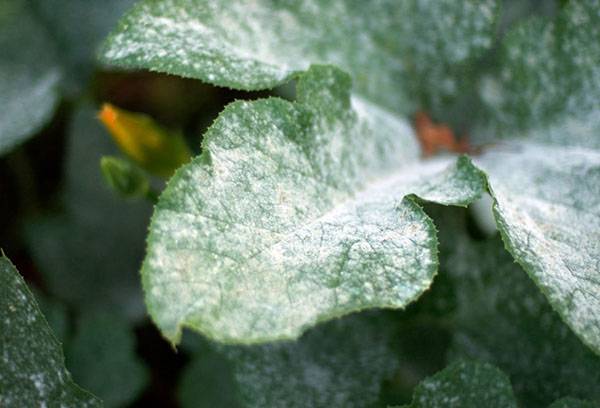
Powdery Mildew on a Chrysanthemum Leaf
Diseases and pests of indoor chrysanthemum
The succulent foliage of indoor chrysanthemum is very attractive to various pests: especially often this plant is attacked by a spider mite. At the initial stage of infection, it is enough to treat the bushes with soapy water and bathe under a warm shower, but when a web appears on the shoots, drastic measures and the use of special preparations will be needed.To prevent the spread of insects, you should regularly inspect the plants and, at the first sign of infection, treat on time. For prevention, you can add essential oil to the water for spraying at the rate of 10 drops per 1.5 liters of water, using this solution once a week.
Fungal diseases are not uncommon for chrysanthemums. They arise due to errors in care, especially often - due to abundant watering. Plants can become infected with powdery mildew, in which the leaves become covered with white coating, and then fall off. For treatment, you need to use fungicide, and also stop watering, dry the roots, and then water it not as abundantly as before. When overflowing, the root system may suffer or septoria may occur, which manifests itself in brown spots on the leaf plate. With such symptoms, watering is reduced, and the leaves are sprayed with special drugs.
Output
Indoor chrysanthemums are flowers that are easy to care for, it’s enough to follow a few rules: place the plants in a cool, bright place, regularly pinch the shoots and sprinkle and water abundantly, but do not fill. Most varieties grown in the pot are garden hybrids with a compact crown, blooming profusely in the fall, and sometimes in the spring.
Indoor chrysanthemums need a winter dormancy at low temperatures. You should prepare for it in advance by choosing a place for wintering and pruning long shoots to 10-15 cm if the flower will winter in a dark room. With a light arrangement, only dried flowers, branches and leaves are removed. Of the pests, chrysanthemum is most often damaged by a spider mite. The most common diseases are fungal - they arise due to errors in growing the flower and with excessive watering. To prevent disease, you must follow the rules of care and regularly inspect plants for pests.
